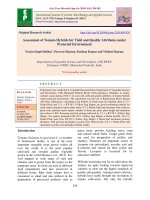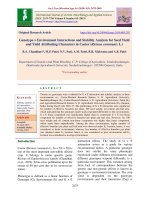Assessment of rice variety Abhishek for higher yield and income under organic farming of North Sikkim, India
Bạn đang xem bản rút gọn của tài liệu. Xem và tải ngay bản đầy đủ của tài liệu tại đây (204.2 KB, 6 trang )
Int.J.Curr.Microbiol.App.Sci (2018) 7(3): 410-415
International Journal of Current Microbiology and Applied Sciences
ISSN: 2319-7706 Volume 7 Number 03 (2018)
Journal homepage:
Original Research Article
/>
Assessment of Rice Variety Abhishek for Higher Yield and Income
under Organic Farming of North Sikkim, India
Ambika Sharma1* and T.T. Bhutia2
1
SMS (Agronomy), Krishi Vigyan Kendra, Mangan, North Sikkim– 737 116, India
2
Krishi Vigyan Kendra, Mangan, North Sikkim– 737 116, India
*Corresponding author
ABSTRACT
Keywords
Abhishek variety,
Frontline
demonstration,
Organic, Rice, Sikkim
Article Info
Accepted:
04 February 2018
Available Online:
10 March 2018
The KVK, Mangan, North Sikkim conducted On Station Trials and
Frontline Demonstrations to evaluate the suitability and profitability of high
yielding rice variety Abhishek over local variety Attey as check in different
locations. Improved organic cultivation practices were followed for the
Abhishek variety and traditional farmer practices for the local check
variety. The results indicated that the yield increase of 46.34 to 51.72
percent in Abhishek variety was recorded over local variety. Highest yield
of 37.70 qt/ha with net return of Rs. 1,22,500 and C:B ratio of 2.85 could
be obtained from the Abhishek variety in Ramthang village during 2017
season.
Introduction
The North eastern state of India, Sikkim is a
tiny hilly state located at the foothills of the
Himalayan range and is often referred as the
‘Nature’s Paradise’ for its scenic beauty. Rice
is the staple food grain in Sikkim next to
maize grown exclusively during Kharif
season. Bestowed with varied agro-climatic
conditions, Sikkim produces some of the
major crops such as cardamom, ginger,
turmeric, off-seasons vegetables, flowers,
kiwi, paddy, maize and millets. But the
farmers of Sikkim are always inclined towards
rice cultivation. The cultivation of rice has
rather become like a tradition for the people
and every year with the onset of monsoon
marks the importance of rice cultivation for
the Sikkimese people. A large number of
landraces of rice both dry land and wetland
were cultivated but almost all paddy landraces
are now slowly disappearing due to lack of
conservation methods, low productivity, lack
of recent production technologies and so on.
The productivity of rice in Sikkim is at a very
dismal figure of average 18.45 qt/ha (FS &
ADD, 2017). In order to meet the future food
demands for the teeming population of the
state, it is vital to give much emphasis on
enhancing rice productivity. Most of the
farmers are hesitant to take up rice cultivation
410
Int.J.Curr.Microbiol.App.Sci (2018) 7(3): 410-415
as its total factor of productivity is declining
and its profitability is in question with the rise
in input costs. Modern crop management
practices have been developed, but in most of
the cases, farmers are not applying these
technologies. There is certainly a gap between
recommended and farmer’s practices. This gap
is responsible for the low productivity and
lower returns. Hence new innovations and
initiatives are required to make rice production
system more sustainable and economically
profitable. Under these circumstances,
introduction of highly improved and high
yielding varieties which performs well under
organic management of Sikkim condition is
one of the good options.
Trial of paddy variety Abhishek was done first
at North Sikkim KVK Farm to check its
adaptability. System of Rice Intensification
(SRI) and Organic Nutrient Management
practices were followed for the Frontline
Demonstration (FLD) of improved variety
Abhishek. Popular farmer’s variety Attey was
used as the Local Check variety for the
demonstration study. The other detail
technologies interventions for the selected
improve variety and farmer practices followed
for check variety are given in Table 1.
Observations on different growth and yield
parameters were taken and economic analysis
was done by calculating cost of cultivation,
gross return, net return and B: C ratio.
Keeping view upon this, Krishi Vigyan
Kendra, Mangan, North Sikkim, had taken up
Front Line Demonstration (FLD) to check the
suitability of paddy variety that will be
adaptable and profitable for the local farming
community. Front Line Demonstration (FLD)
is one of the extension methods to evaluate
performance of technology under on-farm
conditions, technology adoption by the
participating farmers and its diffusion to nonparticipating farmers. These types of on-farm
demonstration are so far the most effective
extension methods (Chizari et al., 1999; Eke
and Emah, 2001). In the present study, the
Abhishek variety from CRRI, Cuttack was
selected for assessment and performance over
popular local variety Attey.
To Study the influence of the demonstrated
technology, the percent increase in yield over
farmers practice, the extension gap,
technology gap and technology index were
calculated using the following formula as
suggested by Samui et al., (2000).
Materials and Methods
Abhishek is a high yielding rice variety
released from Central Rice Research Institute
(CRRI), Cuttack, Orissa. Unlike other
varieties, with a gestation period of 135-140
days, this variety is ready for harvest by only
115-120 days. Even if there is delay in
transplanting due to delay in harvest of
previous crops or late release of water in the
seasonal streams, the crop could be harvested
with good yield. Such delay would have
adverse effect on other varieties. Due to its
The present study was conducted by Krishi
Vigyan Kendra, Mangan, North Sikkim, in the
three villages (Gor, Taryeng and Ramthang)
of Mangan district during Kharif season for
three consecutive years of 2015, 2016 and
2017. A total of 60 numbers of front line
demonstrations was conducted in theses three
villages. Before Frontline Demonstration of
this improve variety, successful On Station
Extension gap (qt/ha) = Demonstration yield
(qt/ha) – Yield of local check (qt/ha).
Technology gap (qt/ha) = Potential yield
(qt/ha) – Demonstration yield (qt/ha).
Technology index (%) = {(Potential yield –
Demonstration yield) / Potential yield} x 100
Details of demonstration variety
411
Int.J.Curr.Microbiol.App.Sci (2018) 7(3): 410-415
early maturing character, its water requirement
is also less, therefore can be grown even under
rainfed condition.
Results and Discussion
Effective tillers per plant, length of panicle
and grains per panicle
More number of filled panicles per plant (13),
longer panicle (18 cm) and higher grains per
panicle (185) were recorded in demonstrated
variety Abhishek as compared to local farmer
variety Attey (Table 2).
The differential response of the varieties could
be attributed to its genetic potentiality and
different packages of practices followed for
the cultivation of demonstrated variety and
farmer variety. These results are in agreement
with those of Sarker et al., (2013).
Due to the improved organic scientific
cultivation practices like seed treatment, green
manure crop and organic manures applied in
the demonstration field (Table 1), the soil
fertility of demonstrated field might have
improved than the farmer practices plot where
no such application of organic manures was
done. Depending upon the farming situation
specific interventions may have greater
implication in enhancing system productivity
(Mukherjee, 2003).
Paddy yield
The results obtained (Table 3) indicated the
percentage increased in the yield of the
demonstrated variety over the farmer’s local
variety in all the three locations. The increased
in the yield of demonstrated variety over the
local variety was 46.34% at Gor, 46.66 % at
Taryeng and 51.72% at Ramthang village.
Highest averaged grain yield of 37.70
quintal/ha was recorded in Ramthang village
during 2017 Kharif season.
The difference in overall increment in the
yield may be due to the overall improvement
in plant growth characters like plant height,
number of filled panicles per plant, panicle
length and number of grain per panicle (Table
2) seen in the demonstrated variety. Similar
results was reported by Kusutani et al., (2000)
that the genotypes which produced higher
number of grains per panicle also showed
higher grain yield in rice.
Extension and technology gap
The extension and technology gap of 17.10,
16.80 and 19.50 quintal /ha and 13.10, 14.00
and 12.30 quintal/ha were recorded
respectively at Gor, Taryeng and Ramthang
village. More and more use of latest
production technologies with high yielding
varieties will subsequently change this
alarming trend of galloping extension gap.
The front line demonstration was laid down
under the supervision of Krishi Vigyan
Kendra at the farmer’s field, but still gap
existed between the potential yield and
demonstration yield. This may be attributed to
dissimilarities in soil fertility, salinity, erratic
rainfall and other vagaries of weather in the
demonstrations area (Mitra and Samajdar,
2010).
Hence, variety wise location specific
recommendation appears to be necessary to
minimize the technology gap for yield level in
different situations. Kadian et al., (1997) also
reported that technology gap can be narrowed
down only by location specific technology
based recommendations.
Technology index
Technology index was recorded to be lowest
during the last year of the study. The
technology index varied from 28.00% to
24.60% with an average of 26.26%.
412
Int.J.Curr.Microbiol.App.Sci (2018) 7(3): 410-415
Table.1 Details of package of practices followed in the frontline demonstrations (FLDs)
Sl.no.
Inputs
1
2
3
Paddy cultivar
Spacing
Seed treatment
4
Organic
application
Demonstration
Farmers practice
Abhishek
20X15cm
Azospirrillum & Phosphate Solubilizing Bacteria (PSB) @ 20gm/kg seed
fertilizer
Attey (Local)
25X25cm
Azospirrillum & Phosphate Solubilizing Bacteria (PSB)
@ 20gm/kg seed
FYM @10-12 t/ha and Vermicompost @2t/ha at the time
of final ploughing and puddling of the field.
i. Buckwheat @ 10-12 kg seeds/acre was broadcasted as green manure which was ploughed back to
incorporate it to the soil after 45 days.
ii. FYM @10-12 t/ha and Vermicompost @2t/ha at the time of final ploughing and puddling of the field.
iii. Inoculation of azolla @ 500 kg/ha, 10 days after transplanting.
Table.2 Comparison of averaged yield attributes of rice between demonstration and local variety
Characters
Demonstration variety (Abhishek)
Local variety (Attey)
55
13
18
185
79
6
17.7
102
Plant height (cm)
No. of filled panicles per plant
Panicle length (cm)
No. of grains per panicle
Table.3 Yield, Technology gap, Extension gap and Technology Index of demonstration
Name of places
Gor
Taryeng
Ramthang
Mean
Years
No. of demonstrations
Potential
yield(qt/ha)
2015
2016
2017
-
15
13
32
-
Demo var.
50
50
50
50
Average Yield
(qt/ha)
Demo var.
36.90
36.00
37.70
36.86
Percent increase
over local
Local var.
19.80
19.20
18.20
19.06
46.34
46.66
51.72
48.22
Techno logy gap
(qt/ha)
13.10
14.00
12.30
13.10
Extension
gap (qt/ha)
17.10
16.80
19.50
17.80
Techno -logy
Index (%)
26.20
28.00
24.60
26.26
Table.4 Economics
Grain yield (qt/ha)
Years
2015
2016
2017
Mean
Demo var.
36.90
36.00
37.70
36.86
Check var.
19.80
19.20
18.20
19.06
Cost of cultivation (Rs./ha)
Demo var.
64,500.00
65,200.00
66,000.00
65,233.33
Check var.
52,500.00
53,000.00
54,000.00
53,166.67
Gross return (Rs./ha)
Demo var.
1,84,500.00
1,80,000.00
1,88,500.00
1,84,333.33
413
Check var.
99,000.00
96,000.00
91,000.00
95,333.33
Net return (Rs./ha)
Demo var.
1,20,000.00
1,14,800.00
1,22,500.00
1,19,100.00
Check var.
46,500.00
43,000.00
37,000.00
42,166.67
B:C ratio
Demo var.
2.86
2.76
2.85
2.82
Check var.
1.88
1.81
1.61
1.76
Int.J.Curr.Microbiol.App.Sci (2018) 7(3): 410-415
The decreased value of technology index in
the last year of demonstration (24.60%)
during 2017 in Ramthang village reflected the
feasibility of the improved package of
practices for the farmers. The lower the
values of technology index more will be the
feasibility of the demonstration (Jeengar et
al., 2006; Sager and Chandra, 2004).
characters were higher in Abhishek variety.
This technology had impacted not only on the
adopting farmer but had also motivated
neighbouring farmers and villages to take up
this technology.
References
Annual Reports, (2017). Food Security &
Agriculture Development Department,
Government of Sikkim.
Chizari, M., Lindner, J. R., and Lashkarara,
F., (1999). Perception of Luristan
Province, Iran Wheat Farmers with
Respect to Sustainable Agricultural
Practices. J. Int. Agril. Ext. Edn., 8: 6572.
Eke, A. G., and Emah, G. N., (2001).
Assessment of Methods Training
Farmers for the Implementation of
Programmes
of
Agricultural
Development Project in Rivers State of
Nigeria. J. Ext. Sys., 17: 76-82.
Jeengar, K. L., Panwar, P., and Pareek, O. P.,
(2006). Frontline demonstration on
maize in Bhilwara district of Rajasthan.
Curr. Agric., 30: 115-16.
Kusutani, A., Tovata, M., Asanuma, K., and
Kui, J., (2000). Studies on the varietal
differences of harvest index and
morphological characteristics of rice.
Japanese J. Crop Sci., 69:359-364.
Mitra, B. and Samajdar, T., (2010). Field gap
analysis of rapseed-mustard through
front line demonstration. Agric. Exten.
Rev., 22: 16-17.
Mukherjee, N., (2003). Participatory Learning
and Action. Concept publishing
company, New Delhi, India, pp. 63-65.
Nirmala B., and P. Muthuraman., (2009).
Economic and constraint analysis of
rice cultivation in Kaithal District of
Haryana. Ind. Res. J. Ext. Edu., 9(1),
47-49.
Sagar, R. L., and Chandra, G., (2004).
Frontline demonstration on sesame in
Economics
The data on production economics (Table 4)
clearly indicated the advantages of growing
demonstration variety over the traditional
local variety. The demonstrated variety
recorded the higher averaged gross return of
Rs 1,84,333 per ha and averaged additional
net return of Rs.1,19,100 per ha over local
check. Higher averaged B: C ratio of 2.82 was
found in demonstrated variety due to higher
net return as compared to local check. This
could be due to high yielding of variety
Abhishek and adoption of scientific
production techniques. Similar results of
adopting high yielding varieties and scientific
methods by farmers in rice for higher
economic return was reported by Sarada and
Khurana
(1993)
and
Nirmala
and
Muthuraman (2009).
Acceptance by farmers
The taste of the rice suits the local palate.
Yield was significantly higher than the variety
used by the farmers. Being impressed by the
successful trials, the farmers are taking up the
variety in large scale with the recommended
management practices and increasing the area
of cultivation under this variety.
From the present study, it can be concluded
that demonstrations of present variety of
paddy with scientific organic management
technology can give promising results in
terms of yield, extension gap and technology
index. It was observed that yield contributing
414
Int.J.Curr.Microbiol.App.Sci (2018) 7(3): 410-415
West Bengal. Agril. Ext. Rev., 16: 7-10.
Samui, S.K., Maitra, S., Roy, D.K.., Mandal,
A.K., and Saha, D., (2000). Evaluation
on front line demonstration on
groundnut (Arachis hypogea L.). J.
Indian Soc. Coastal Agric. Res., 18 (2):
180-183.
Sarada, M.K., and G.S., Khuran, (1993).
Adoption gap and its model class in
recommended rice technology. Indian
journal of Extension Education.,
29(1&2):108-11
Sarker, C.B., Zahan, M., Majumdar, U.K.,
Islam, M.A., and Roy, B., (2013).
Growth and yield potential of some
local and high yielding boro rice
cultivars. J. Agrofor. Environ, 7 (1):
107-110.
How to cite this article:
Ambika Sharma and Bhutia, T.T. 2018. Assessment of Rice Variety Abhishek for Higher Yield
and Income under Organic Farming of North Sikkim, India. Int.J.Curr.Microbiol.App.Sci.
7(03): 410-415. doi: />
415
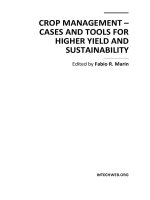
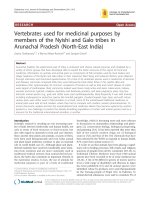

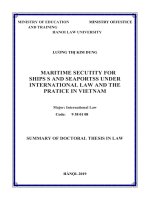

![Heterosis studies for seed yield and earliness in intra-specific hybrids of ricebean [Vigna umbellata (Thunb.) ohwi and ohashi] an under utilized pulse](https://media.store123doc.com/images/document/2020_01/09/medium_pxu1578554402.jpg)


